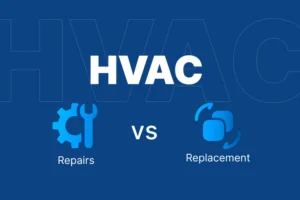Behind every comfortable home is an HVAC system, quietly keeping things just right in every season. Whether it’s summer heat or winter chill, a fully functioning heating and air conditioning system keeps your home comfortable year-round. Unfortunately, even with careful inspections, it can break down without warning. And this might leave you asking – does a home warranty cover HVAC malfunction? The answer is yes! No matter the age of your HVAC system, a home warranty covers it.
In this blog, we’ll walk you through what home warranty coverage looks like for your HVAC system. We’ll also highlight what’s typically included (and what’s not) and how to pick the plan that works best for you.
Table of Contents
-
-
-
- Does a Home Warranty Cover HVAC System?
- Which Parts of HVAC Does a Warranty Cover?
- Evaluating HVAC Repairs or Replacement Costs
- When Should You Consider Replacing Your HVAC System?
- Does a Home Appliance Warranty Cover a Full HVAC Replacement?
- Things to Know About Home Warranty With HVAC Coverage
- Why do you Need a Home Warranty for HVAC Coverage
- Finding the Right Warranty Plan that Covers HVAC Unit
-
-
Does a Home Warranty Cover HVAC System?
Yes, home warranties cover heating and air conditioning systems, but the extent of that coverage depends on your plan. Hence, it is crucial to review the terms and pick a warranty that aligns with your needs.
While coverage can vary by provider, most home warranties include primary home systems like HVAC, plumbing, and electrical. They also cover essential appliances such as refrigerators, ovens, washers, and more.
If your system stops working, the first thing to do is to contact your warranty provider to file a claim. From their network of contractors, they will arrange for a technician to diagnose the issue. The technician will visit your house to assess the issue and handle any necessary repairs. It is a quick and straightforward process that saves you from the trouble of finding a contractor on your own.
Which Parts of HVAC Does a Warranty Cover?
Most home warranties have your back when it comes to the important parts of your HVAC system. From central air conditioning and furnaces to wall heaters and forced air systems (whether gas, electric, or oil), you are covered.
Here’s a quick guide to help you understand which parts are protected:
-
- Primary Components: Your AC’s compressor, evaporator coils, and blower motor are commonly included in coverage.
- Heating Systems: Furnaces, heat pumps, and similar heating systems are part of most plans.
- Ductwork: Duct leaks can waste energy. Many warranties include ductwork repairs to keep things efficient.
- Thermostat: Your thermostat is covered, too. So if it malfunctions, it won’t cost you extra to replace or repair.
When considering coverage, it’s important to remember that different systems need varying levels of protection. If you’re wondering, does a home warranty cover HVAC units of all types? Fortunately, most companies do provide coverage. Here’s the list:
-
- Split Systems
- Duct-free (Mini Split Systems)
- Hybrid split systems
- Packaged HVAC systems
- Geothermal HVAC systems
- Heat pumps
Evaluating HVAC Repairs and Replacement Costs

Repairing an HVAC system can be costly, especially as systems age. You can expect to pay anywhere from $100 to $600 for repairs, with most falling around $350.
However, the actual cost hinges on which part needs to be repaired or replaced. Parts replacements, like a motor or coil, can cost as much as $2,000. Whereas, for major components like an A/C compressor or furnace heat exchanger, costs can surpass $5,000.
Replacing an entire unit can be quite an investment. With costs typically ranging from $5,000 to $12,500, the average price stands at around $7500. The price can vary based on factors like the size of the system, its type, the brand, and even local labor rates.
When Should You Consider Replacing Your HVAC System?
Deciding between HVAC repair or replacement? The $5,000 rule is a handy guideline to make things easy for you. First, multiply your system’s age by the repair estimate. If the final number is over $5,000, replacement is often the more cost-effective route. If it falls below $5,000, repairing could extend the life of your system without draining your budget.
This simple calculation offers a practical way to weigh your options and make confident choices. But, cost alone shouldn’t drive your decision. Consider the system’s age, efficiency, and condition. A newer system not only operates more efficiently but also reduces the likelihood of future repairs. Making the right choice can save energy and ensure reliable service for years to come.
Does a Home Appliance Warranty Cover a Full HVAC Replacement?
Repair is often the first step in the process when dealing with an HVAC issue. It is typically faster and more convenient than waiting for a full replacement. However, if the system is deemed beyond repair, replacement is the only solution.
Hence, this leads to a common question – does a home warranty cover HVAC systems in such cases? Yes, it does. The warranty is there to cover a new unit. Replacing the system can be a significant expense. So, having financial backup eases the stress when unexpected breakdowns occur.
Need to repair or replace your HVAC system? We have got you covered! Explore our warranty plans or call us at 800-670-8931 for any queries.
Things to Know About Home Warranty With HVAC Coverage
Though home appliance warranties provide valuable protection, it’s essential to understand the limitations and exclusions upfront. Knowing what’s covered and what isn’t can help you avoid confusion later.
Common HVAC Problems Covered by Home Warranties
-
- Normal wear and tear from everyday HVAC system use
- Age-related failures impacting the system’s performance
HVAC Issues Not Covered by Warranties
-
- Damage to portable air conditioners or smaller cooling units
- Pre-existing issues at the time of purchasing the warranty
- Problems due to neglected HVAC maintenance or poor care
- Natural disaster damage, including flooding or fires
If your heating and air conditioning system breaks down or sustains damage from natural calamities or accidents, home insurance can help cover the costs. This includes protection against fire and smoke, lightning strikes, wind, hail, snow, ice, and falling trees.
Why Do You Need a Home Warranty for HVAC Coverage?
HVAC problems can be both disruptive and expensive, with electrical components, compressor failures, and refrigerant leaks topping the list of common problems. Compressor repairs, in particular, can be costly if a warranty doesn’t cover your unit.

Having a home warranty in place can ease the burden by covering critical repairs and replacements. By understanding the risks and costs involved, you’ll be better prepared to decide when repairs make sense or if it’s time for an upgrade. When replacement seems like the better option, home warranties can help manage the expense.
Finding the Right Warranty Plan that Covers HVAC Unit
Sometimes, asking the right questions and staying informed is the best way to select an ideal plan for your HVAC coverage. Customer service teams are always there to explain coverage details and address concerns. So, take your time to thoroughly review the plan, raise queries, and dig into the specifics of what’s included and what’s not.
Taking a proactive stance can help you feel more confident in your warranty choice and prevent misunderstandings. Also, when purchasing a warranty, you might find yourself asking – does a home warranty cover HVAC systems that are older? The good news is that, yes, your aging HVAC unit is also eligible for coverage.
At Select Home Warranty, the age of your home systems or appliances isn’t a dealbreaker. If everything is working well when you sign up and stay maintained, old HVAC units are also covered. Your comfort is our priority, so we make sure you are prepared for whatever challenges your HVAC systems bring your way!

